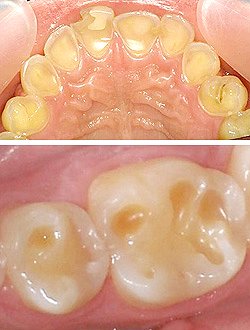
Treatment of tooth erosion (restore tooth enamel)
Tooth erosion affects the whole surface of the tooth. If the problem is not identified and treated early enough, the damage to tooth structures may be so extensive that it requires expensive cosmetic dentistry to restore function and appearance.
The treatment of dental erosion includes two separate steps. The first step is the identification and elimination of the reasons that have caused the tooth erosion and the second step is to treat the symptoms and to restore tooth enamel loss with restorative procedures by a cosmetic dentist.
A. Eliminate the causes of tooth erosion
Diet. If the cause of the dental erosion is the consumption of acidic foods or drinks, patient education may solve the problem. The patient must make dietary modifications as those described in the next section about the prevention of tooth erosion.
Medical consultation. If the problem is caused by medical condition as GERD the patient must consult a medical doctor for the appropriate treatment. In case of bulimia caused tooth erosion a psychologist may help to treat the condition.
B. Restore tooth enamel loss
Treatment of dental erosion depends on the severity of the damage. If the loss of tooth enamel is moderate without affecting the patient’s appearance, there is no need of restorative treatment. The dentist may recommend certain fluoride treatments and de-sensitizing toothpastes to control the tooth sensitivity symptoms caused by teeth erosion. Enhancing the re-mineralization process by providing minerals such as fluoride may be enough for natural tooth enamel restoration. The dentist may also apply a fluoride varnish on the affected teeth for further protection and repair of tooth enamel.
Restorative cosmetic treatments become necessary if the tooth enamel damage is extensive. Depending on the degree of tooth wear, restorative treatment can range from placement of bonded composites (teeth bonding) in a few isolated areas of teeth erosion, to crowns, dental porcelain veneers, bridges or even full mouth reconstruction in the case of severe tooth enamel damage. A cosmetic dentist has to evaluate the situation and recommend the best cosmetic treatment to restore teeth function and appearance.
After treatment, the patient who has suffered dental erosion must follow a careful preventive plan to avoid further tooth enamel loss and the high expenses of the associated cosmetic treatments.
Regular preventive dental visits are important for the prevention of tooth erosion. During the dental exam, the dental hygienist can easily identify early signs of erosion before it causes significant damage to teeth.
You should always check carefully before you choose a dental insurance if preventive dental visits and 'cosmetic' restorative procedures are covered.
Prevention of dental erosion and tooth enamel loss
Tooth erosion can do severe damage to your teeth, but it is preventable. There are several preventive measures that can be taken to control tooth enamel loss and prevent dental erosion:
- Decrease the consumption of acidic foods and/or drinks, both in quantity and frequency. Try to have them only at mealtimes. Replace carbonated drinks with water, milk or un-sweetened coffee and tea, especially between meals.
- Drink acidic drinks quickly and do not swish them round the mouth (to reduce the time that the teeth are exposed to acids).
- Use a straw when drinking carbonated beverages or fruit juices, which are very acidic (at least to limit contact of acids with the front teeth).
- After eating or drinking acidic foods or beverages, rinse your mouth with fresh water so that the acid is diluted and easier neutralized.
- Because acids temporarily soften the tooth surface (de-mineralization), don't brush your teeth immediately after eating or drinking something acidic (or vomiting), as the softened enamel will be further damaged by the brushing and that will speed up the process of erosion. Wait at least an hour to allow calcium in saliva to repair tooth enamel after the acid exposure.
- Chewing sugar-free gum can help reduce dry mouth and increase the saliva flow, allowing it to neutralise acids and help teeth to remineralize.
- You should brush your teeth twice a day, with a soft toothbrush using fluoride toothpaste. Fluoride helps the remineralization of the tooth enamel and it is necessary for preventing tooth erosion.
- Follow your dentist’s instructions in order to prevent further tooth enamel loss. Your dentist may also recommend the periodic application of fluoride gel or varnish in the dental office to restore tooth enamel and prevent dental erosion.
![]() The cost involved with tooth restoration can be significant and many patients may not afford it if they are not covered by their dental insurance.
Learn how to choose a dental insurance plan that will provide the best dental treatment to yourself and your family.
The cost involved with tooth restoration can be significant and many patients may not afford it if they are not covered by their dental insurance.
Learn how to choose a dental insurance plan that will provide the best dental treatment to yourself and your family.



